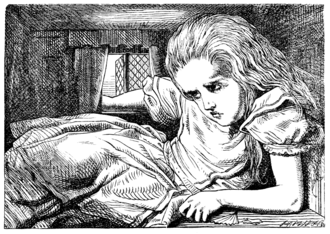Perspective distortion
A perspective distortion is defined as a subtle to extreme change in how a person perceives the size and distance attributed their body, to specific parts of the external environment, or to the external environment as a whole.[1]
This effect is capable of manifesting itself in 4 different ways which may reflect the failure of each respective responsible visual function.[2]
- Size distortions:
When affecting distance, perspective distortions can make things seem as if they are physically closer or further away than they usually would be. This can range from a subtle experience, such as the other side of the room feeling marginally further away than it usually would be, to an extreme experience, such as feeling as if the horizon is right in front of you.
When affecting size, perspective distortions can make things seem as if they are physically smaller or larger in terms of the sense of size that one would usually attribute to them.[7][8][9] This can range from a subtle experience, such as the room feeling marginally smaller and more cramped than it usually would be, to an extreme experience, such as feeling as if the room is hundreds of miles wide.
Perspective distortions are often accompanied by other coinciding effects such as depth perception distortions and visual disconnection. They are most commonly induced under the influence of moderate dosages of dissociative compounds, such as ketamine, PCP, MXE, and DXM.
Alice in Wonderland Syndrome

Alice in Wonderland Syndrome (AIWS) is characterized by macropsia, micropsia, pelopsia, teleopsia, altered perception of shape (meta-morphopsia), and time distortion.[10]
Feelings of suddenly having an impossibly giant or tiny body are also a very common manifestation of this effect. This feeling is already known by the scientific literature as “Alice in Wonderland Syndrome”, where it is seen as a temporary condition often associated with migraines, brain tumours, and the use of psychoactive drugs.[1][11] The effect can either be attributed to the body as a whole or specific parts of it. For example, feelings of having a huge head or tiny limbs are possible.
Lilliputian hallucinations
Lilliputian hallucinations, also known as microptic or diminutive hallucinations, are a form of autonomous entity characterized by their small size.[12] They are occasionally accompanied by enormous beings of a similar sort, also known as gulliverian or brobdingnagian hallucinations.
Psychoactive substances
Compounds within our psychoactive substance index which may cause this effect include:
- 1B-LSD
- 1P-LSD
- 1V-LSD
- 1cP-LSD
- 25B-NBOH
- 25C-NBOH
- 25I-NBOH
- 25I-NBOMe
- 2C-B-FLY
- 3-Cl-PCP
- 3-HO-PCE
- 3-HO-PCP
- 3-MeO-PCE
- 3-MeO-PCMo
- 3-MeO-PCP
- 3C-E
- 3C-P
- 4-AcO-DET
- 4-AcO-DMT
- 4-AcO-MiPT
- 4-HO-DET
- 4-HO-DPT
- 4-HO-DiPT
- 4-HO-EPT
- 4-HO-MPT
- 4-HO-MiPT
- 4-MeO-PCP
- 5-MeO-DiPT
- ALD-52
- Allylescaline
- Amanita muscaria
- Bromo-DragonFLY
- DET
- DOB
- DOC
- DOI
- DOM
- Deschloroketamine
- Dextromethorphan
- Diphenidine
- Ephenidine
- GBL
- GHB
- Gaboxadol
- HXE
- Ibogaine
- Ketamine
- LSD
- LSM-775
- LSZ
Experience reports
Anecdotal reports which describe this effect within our experience index include:
- Experience: 1 tab 1P-LSD (oral) - Finding myself within the forest
- Experience:1000 Morning Glory seeds - Rediscovering the Self
- Experience:1000mg / 1200mg / 1400mg / 1600mg - heroic doses
- Experience:110mg Diphenidine (vaporized) + 354mg DXM - instant ego death
- Experience:200 mg of MXP + N2O:20 chargers
- Experience:25mg (insufflated) - Simultaneously amazing and horrible
- Experience:260 mg Ketamine (insufflated) - Lost in Paisley
- Experience:3-MEO-PCMo (420mg) - Trip Report
- Experience:354mg DXM, weed, nicotine - Descending into the void
- Experience:40mg - Brothermind and the Forest's Hand
- Experience:5.3g psilocybe cubensis - Dimensional Circumstance and the Fabric of Understanding
- Experience:5g Mushrooms - Failed attempt at a Terence Mckenna style trip.
- Experience:700mg - To the dextroverse.
- Experience:750mg - Experiencing Void; Dissociation Of Reality And Self
- Experience:LSD (230 ug) - An amazing adventure by vikilikepsych
- Experience:Mushrooms (~0.5 g) - Autonomous Voice
- Experience:Psilocybin Mushroom (0.16 g, Oral) - Dosage Independent Intensity
- Experience:Unknown dosage / 3 tabs - Ego death and a total break through in the snow
See also
External links
References
- ↑ 1.0 1.1 G Lerner, A., Lev-Ran, S. (2015). "LSD-associated "Alice in Wonderland Syndrome"(AIWS): A Hallucinogen Persisting Perception Disorder (HPPD) Case Report". The Israel Journal of Psychiatry and Related Sciences. 52 (1): 67–68. ISSN 2617-2402.
- ↑ Schneck, Jerome M. (1965). "MACROPSIA". American Journal of Psychiatry. 121 (11): 1123–1124. doi:10.1176/ajp.121.11.1123. ISSN 0002-953X.
- ↑ "macropsia". APA Dictionary of Psychology. Retrieved 20 May 2022.
- ↑ "micropsia". APA Dictionary of Psychology. Retrieved 20 May 2022.
- ↑ "pelopsia". Medical Dictionary. Retrieved 20 May 2022.
- ↑ "teleopsia". APA Dictionary of Psychology. Retrieved 20 May 2022.
- ↑ Abraham, Henry David (1983). "Visual Phenomenology of the LSD Flashback". Archives of General Psychiatry. 40 (8): 884. doi:10.1001/archpsyc.1983.01790070074009. ISSN 0003-990X.
- ↑ Horowitz, Mardi J. (1969). "Flashbacks: Recurrent Intrusive Images After the Use of LSD". American Journal of Psychiatry. 126 (4): 565–569. doi:10.1176/ajp.126.4.565. ISSN 0002-953X.
- ↑ Hamilton M (ed): Fish's Clinical Psychopathology. Baltimore, Williams & Wilkins Co, 1974. https://books.google.com/books?hl=en&lr=&id=gHdQTZNkA9YC&oi=fnd&pg=PA1&dq=Hamilton+M+(ed):+Fish%27s+Clinical+Psychopathology.&ots=okWOwjZJfq&sig=Y85lNwTChlGIhtdhohkn-MXSyCA#v=onepage&q=Hamilton%20M%20(ed)%3A%20Fish's%20Clinical%20Psychopathology.&f=false
- ↑ Cau, C (October 1999). "[The Alice in Wonderland syndrome]". Minerva medica. 90 (10): 397–401. PMID 10767914.
- ↑ Blom, Jan Dirk (2016). "Alice in Wonderland syndrome". Neurology: Clinical Practice. 6 (3): 259–270. doi:10.1212/CPJ.0000000000000251. ISSN 2163-0402.
- ↑ Blom, J. D. (June 2021). "Leroy's elusive little people: A systematic review on lilliputian hallucinations". Neuroscience & Biobehavioral Reviews. 125: 627–636. doi:10.1016/j.neubiorev.2021.03.002. ISSN 0149-7634.